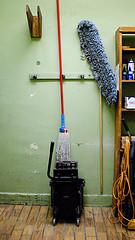 Tragic school-wide shootings notwithstanding, we like to think that our public schools are mostly safe. According to a recent report by the Environmental Working Group (EWG), however, our children may be breathing toxic fumes in the classroom.
Tragic school-wide shootings notwithstanding, we like to think that our public schools are mostly safe. According to a recent report by the Environmental Working Group (EWG), however, our children may be breathing toxic fumes in the classroom.
The EWG tested 13 different school districts in California, and found that the cleaning supplies used could cloud the air with more than 450 toxic contaminants, including those linked with asthma and cancer. (The 13 districts were chosen for geographic and size diversity.)
“Classroom cleaners can deliver harmful fumes to millions of school children each day,” said Rebecca Sutton, Ph.D. and author of the study, “and parents have no way to know about it. Cleaning products aren’t required to list ingredients on the label, leaving school systems and everyday consumers without critical information to make the smart choices.”
Some of the chemical toxins found include formaldehyde, styrene, and alkyl dimethyl benzyl ammonium chloride (ADBAC), all of which can lead to asthma. Also found were toxins linked to increased cancer risk like chloroform, trichloroethylene, benzene, acetaldehyde, 2-butoxyethanol, and 3-epoxypropane.
According to the EWG, schools aren’t the only places using potentially dangerous cleaning products-many parents also use them in their homes. Over 20 of the products they tested in schools are the same as those commonly used in households, including Comet Disinfectant Powder Cleanser, which produced fumes that included formaldehyde, benzene, chloroform, and four other toxins identified by the state of California as causing cancer or reproductive harm.
Overall, children are at greater risk of health damage from inhaling or ingesting toxic substances than adults. According to Grassroots Environmental Education in New York, children’s immature organs and developing bodies make it more difficult for them to detoxify or eliminate poisons, and because of their size, they receive proportionally greater doses of chemical contaminants found in food, water, and air. “Even a small exposure occurring during a critical ‘window” of a child’s development could cause permanent health effects,” they report. They add-as the EWG did as well-that the incidence of childhood cancers is increasing, that childhood asthma rates have doubled in the past decade, and that developmental and learning disabilities are diagnosed more often than ever.
Fortunately, some schools have already taken action, and are employing “greener cleaners” in the classrooms. The EWG confirms that most of these cleaning supplies produce lower pollution levels and fewer chemicals than conventional products, yet do not increase costs. “Green cleaning has proven to be one of the easiest and cost-effective ways for schools to make their facilities healthier and safer for students,” said Dean Kubani, Director, City of Santa Monica Office of Sustainability and the Environment.
Meanwhile, the lack of information on labels still makes it difficult for schools and parents to make informed decisions. “The alarming truth is that we know far too little bout what’s in the cleaning supplies used in schools-and in our homes,” said the EWG report. The news has created a ripple in regulation, however, as according to the EWG press release, New York Representative Steve Israel (D) and Minnesota Senator Al Franken (D) recently introduced federal legislation to require household cleaning products to list the ingredients on the label of all items.
In the meantime, to help keep your family safe, remind your child to keep his hands away from his mouth while at school, and to wash frequently. Then, choose safer, greener household cleaners for your home. Look for those labeled “non-toxic,” “bio-based,” “natural or organic,” or make your own using recipes such as those suggested here.
Have you made changes in your household cleaners? Please share your story.
Photo courtesy David Chu via Flickr.com.

